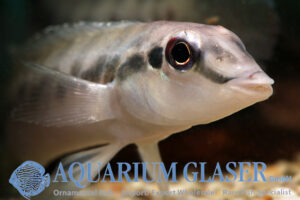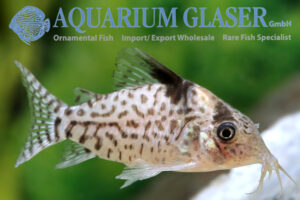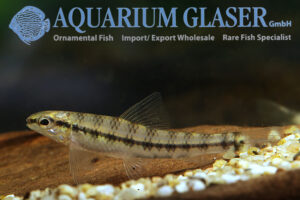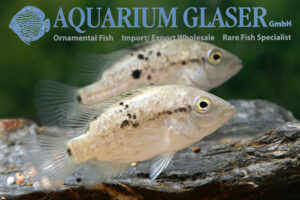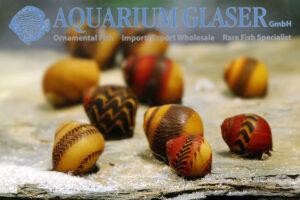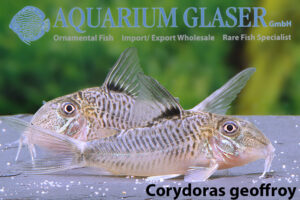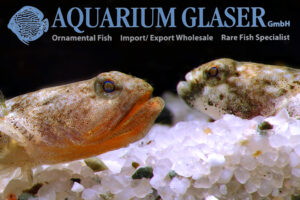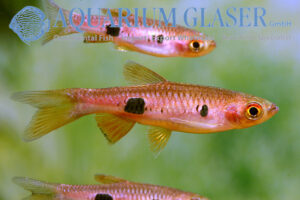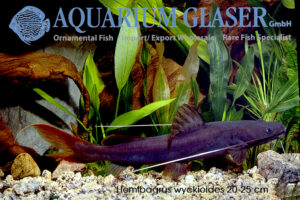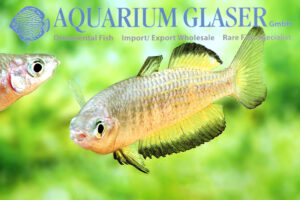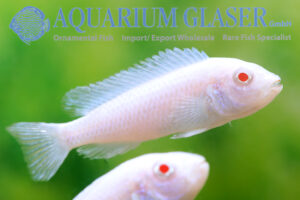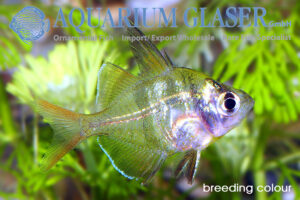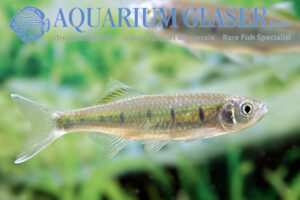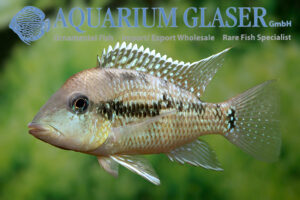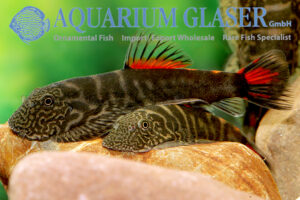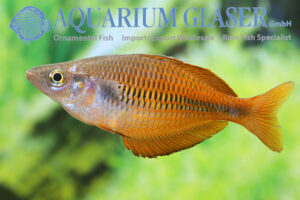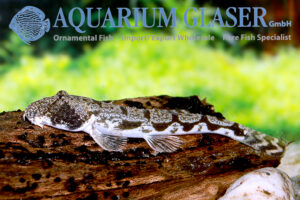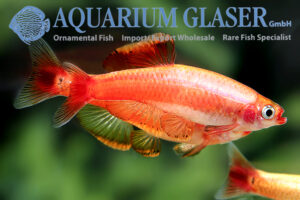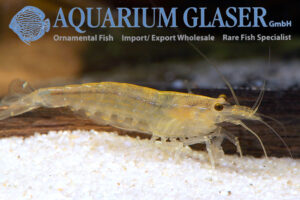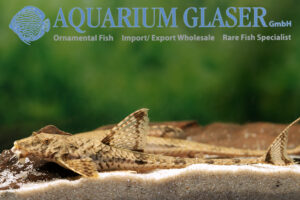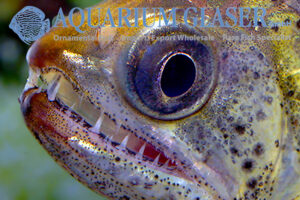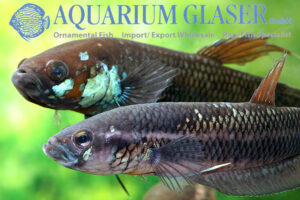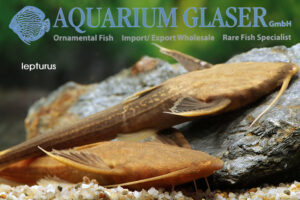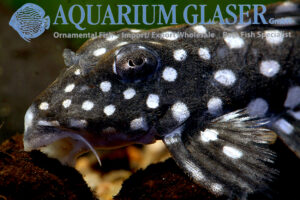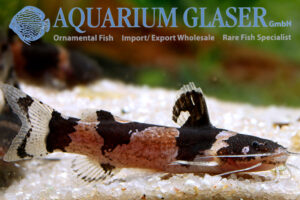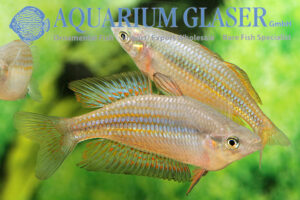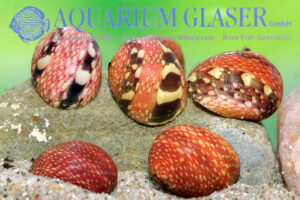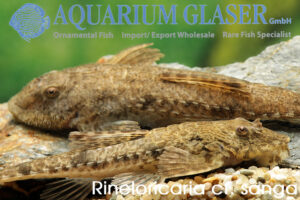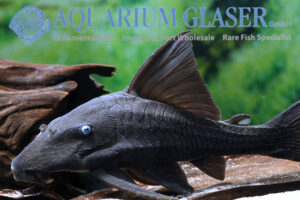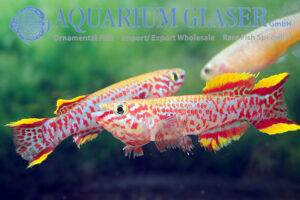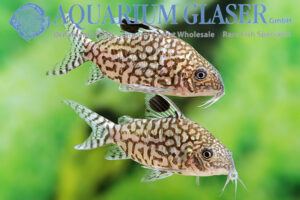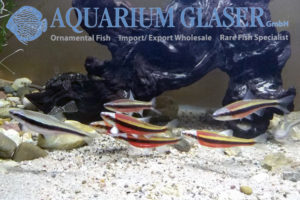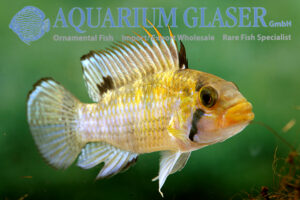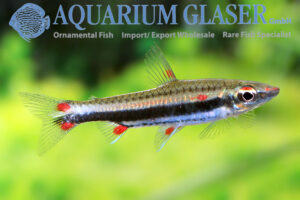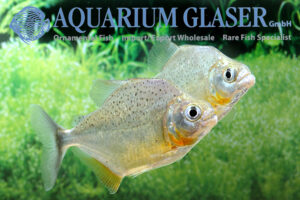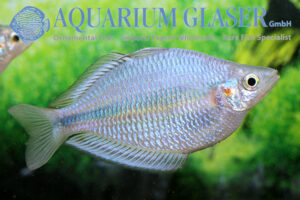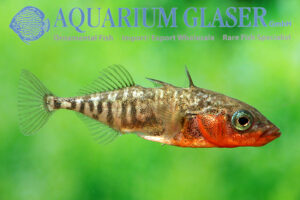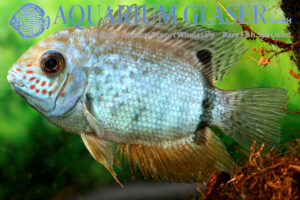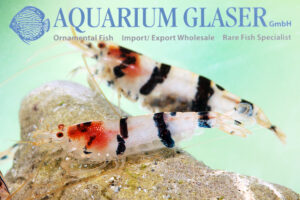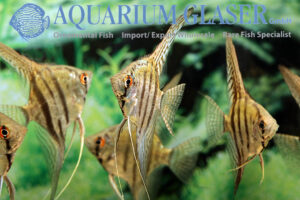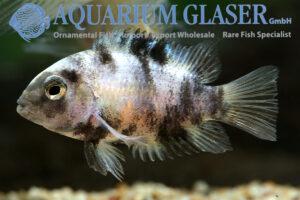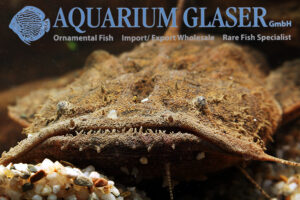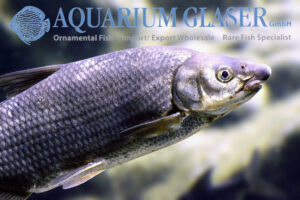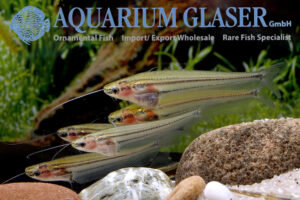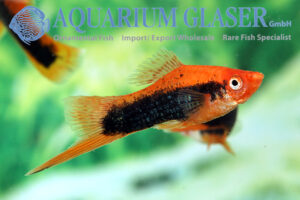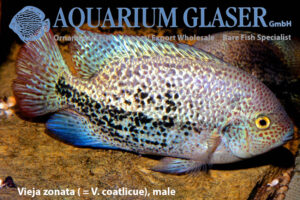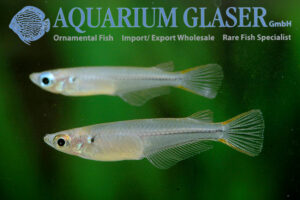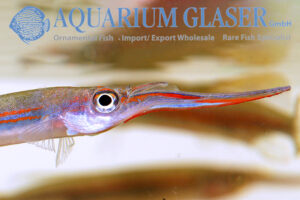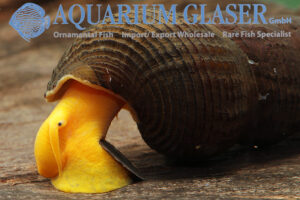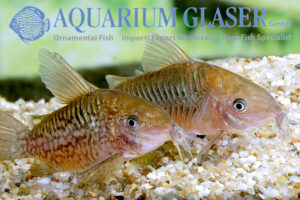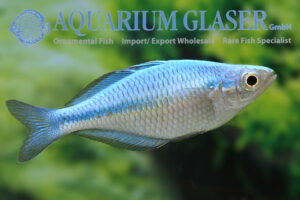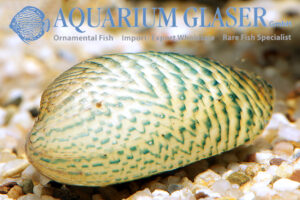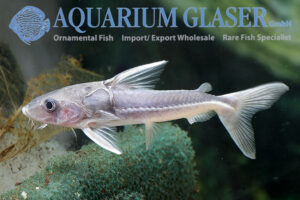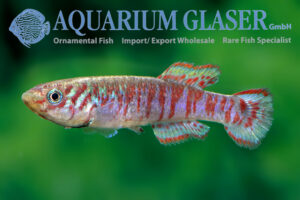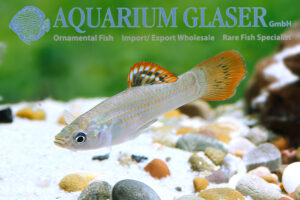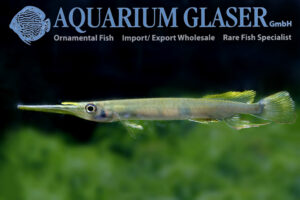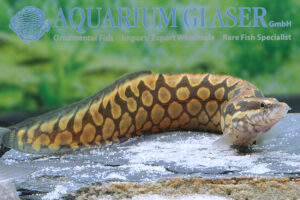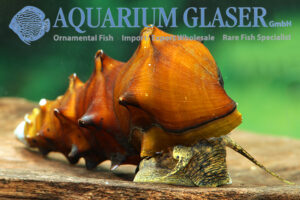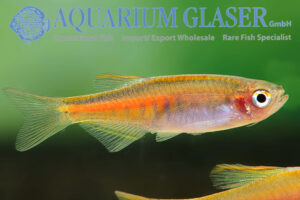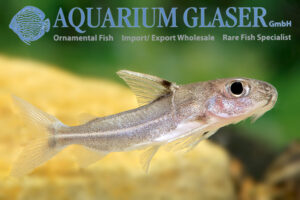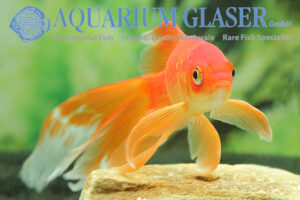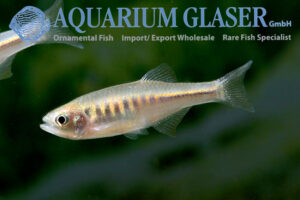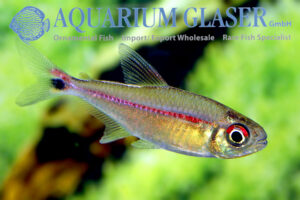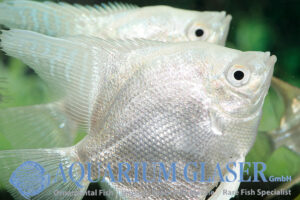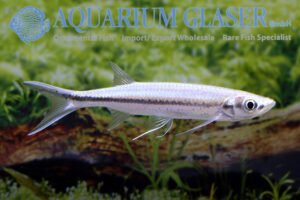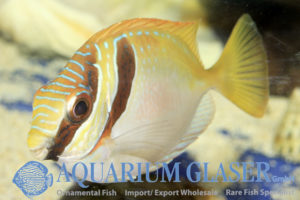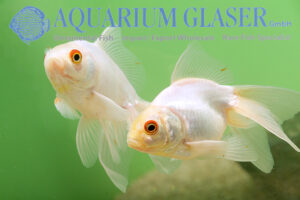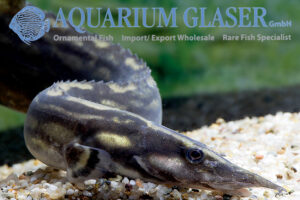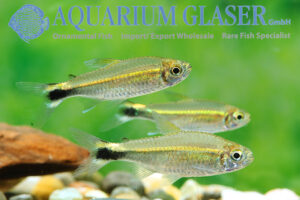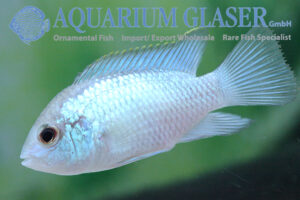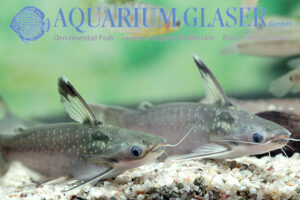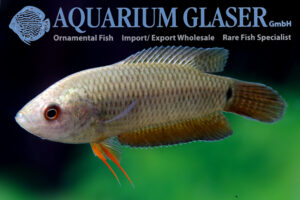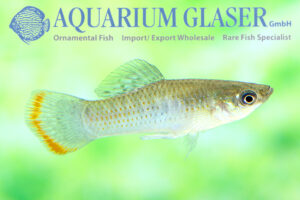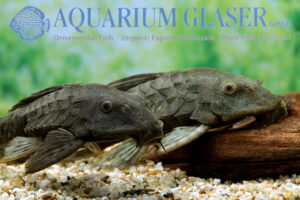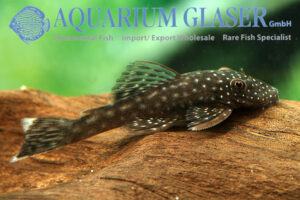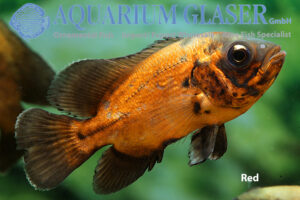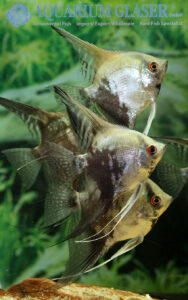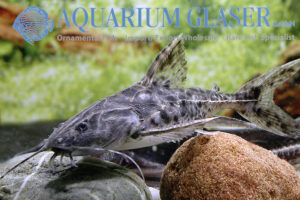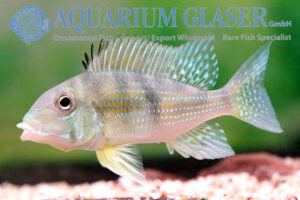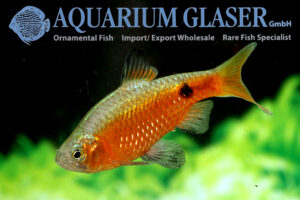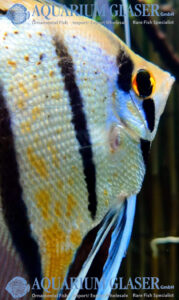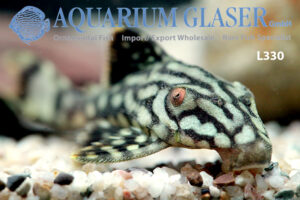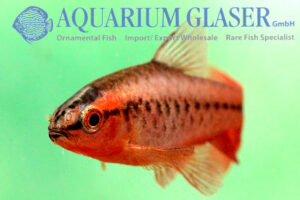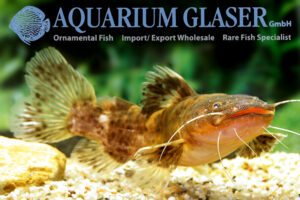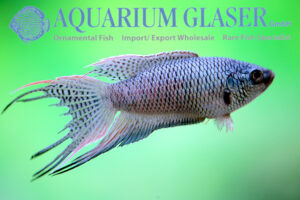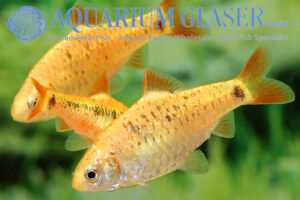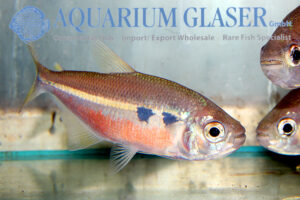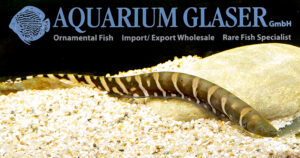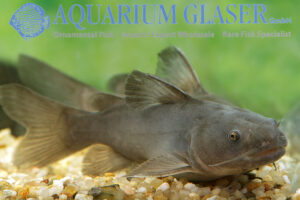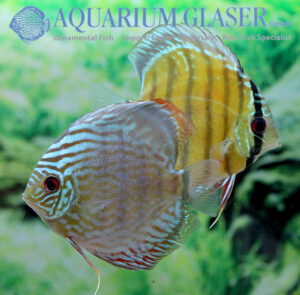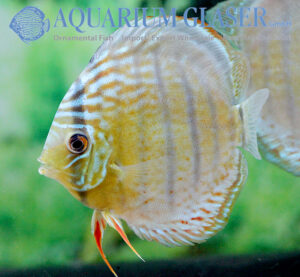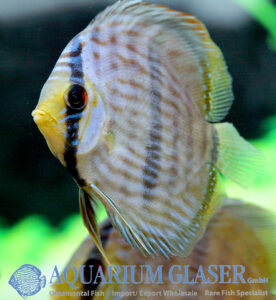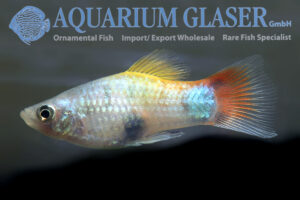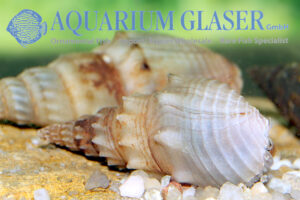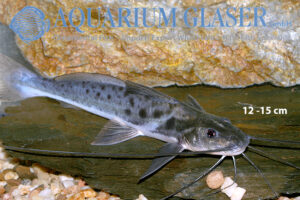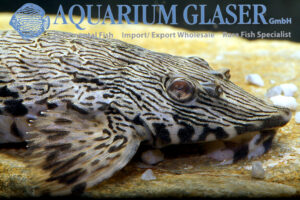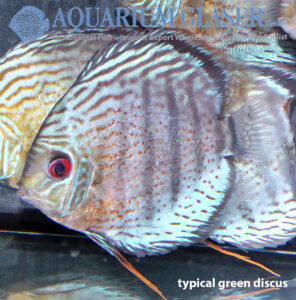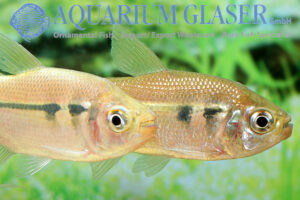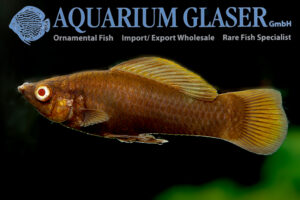The cichlids of the genus Teleocichla are very closely related to Crenicichla. They remain relatively small, the T. preta discussed here is one of the largest species with a maximum length of 15 cm. The swim bladder is greatly reduced in Teleocichla. Without active swimming movements, they cannot stay afloat. Ecologically, the Teleocichla could be […]
Fish Archive (3076)
-
-
Corydoras ambiacus (now: Brochis ambiacus)
Corydoras ambiacus is one of the longest known species of the enormously diverse armored catfish, which has recently been assigned to the genus Brochis in a major review of armored catfish. The species Corydoras ambiacus was formally described from the Rio Ambyiacu in Peru as early as 1872. At that time, only 5 Corydoras species […]
-
Characidium steindachneri
With 97 described species, 67 of which are considered to be valid by the majority of scientists, the bottom-dwelling ground tetras (Characidium) are extremely species-rich. Unfortunately, there is no complete overview of the genus. Misidentifications or at least uncertainties prevail in both scientific and hobbyist literature. One of the most frequently cited species in the […]
-
Nandopsis haitiensis
Although the current classification of the cichlids from Central America, formerly grouped together under Cichlasoma, has been around for a few years now, many genus names have been slow to catch on in the hobby. The main reason for this is, of course, that the large cichlids of Central America are currently only kept and […]
-
Vittina waigiensis
If there was a beauty contest between the nertine snails: the species commonly known in the hobby as Neritina or Vittina waigiensis would certainly be among the winners! This species, which reaches a shell diameter of 1.5-2 cm and has extremely variable markings, was originally described by Lesson in 1831 as Neritina waigiensis. The animals […]
-
Corydoras have been revised – “new” genus names!
The armored catfish (Callichthyidae) are a species-rich family that occurs exclusively in South America. There are two subfamilies, the callichthyid catfishes (Callichthyinae) and the corydoras-like armored catfishes (Corydoradinae). The latter are particularly species-rich. Currently (June 2024), 231 species are considered to be described, 171 of which are generally recognized as valid; in addition, there are […]
-
Schismatogobius risdawatiae
The dragonet gobies (Schismatogobius) are small species of freshwater gobies, that reach between 3 and 5 cm length. They live in small rivulets near the coast but above the tide on sandy bottoms. Here they burry themselves very fast if necessary. The larvae devolop – as far as this known – in the sea. The […]
-
Rasbora kalochroma
One of the undoubtedly most beautiful Rasbora species is R. kalochroma – and one of the most sensitive. They are typical black water fish which react very sensitively during the acclimatisation phase to increased bacteria contamination, which occurs almost inevitably in “normal” water. When we were now offered youngsters, we took advantage, because young fish […]
-
Hemibagrus wyckii and H. wyckioides
These large predatory catfish from Southeast Asia usually grow to around half a meter in length. The maximum length given for H. wyckioides is up to 130 cm and 86 kg in weight, while “only” around 90 cm is given for H. wyckii. They are important food fish and are highly prized for their excellent […]
-
Melanotaenia parkinsoni
Melanotaenia parkinsoni is one of the few species of rainbowfish that are offered relatively regularly in the trade. The home of this maximum 14 cm long, but usually much smaller animal is in Papua New Guinea, in the Central Province. There are only confirmed specimens from the Kemp Welsh River, which is sometimes also referred […]
-
Chindongo socolofi “Albino” ( = Pseudotropheus socolofi)
The question of whether an ornamental fish species is particularly popular can often be answered with “yes” if breeding forms exist. Breeding forms, whose characteristics either do not occur at all in nature or only occur extremely rarely in individual specimens, usually only arise when the natural form is bred on a large scale. The […]
-
Parambassia lala
The Indian glass perch (Parambassia lala, often placed in the monotypic genus Pseudambassis) is actually an old acquaintance (first introduction: 1905), but an incredible amount of nonsense has been and still is spread about it. For example, the rumor persists that the species is a brackish water fish. But it is not, it is only […]
-
Opsarius koratensis
Typical open water fish are very rarely kept in the aquarium. There is a simple reason for this: they are usually quite colorless. The Opsarius koratensis, which can grow to a maximum length of 10-12 cm (some sources even state 16 cm), is no exception. However, keeping these fish can still be very rewarding, as […]
-
Geophagus sp. Alto Sinu
In 2016, French aquarists in Colombia discovered a new eartheater, which they named after the place where it was found in the Rio Cauca inlet – a Rio Sinu. However, this Rio Sinu is not identical to the much larger Rio Sinu of the same name in Colombia! For the exact locality see the article […]
-
Gastromyzon sp. “Bloody Mary”
The hillstream loaches of the genus Gastromyzon have developed an enormous diversity of species on the island of Borneo. The ichthyologist Tan first analyzed this diversity in 2006 and described no less than 15 new species in his book “The Borneo Suckers”. Since then, a total of 36 species of the genus have been known […]
-
Melanotaenia fasinensis
The Bird’s Head Peninsula is part of the large island of New Guinea. It is located in the northwest of New Guinea and belongs politically to Indonesia (West Papua). For rainbowfish enthusiasts, it is currently the holy land, as the Bird’s Head Peninsula is a hotspot of diversity for this group of fish. The most […]
-
Canthophrys gongota ( = Somileptus gongota)
The moose faced loach from India is a very unusual representative of its family. Although there are many loach species that burrow, Canthophrys gongota has perfected this behavior. In its natural habitat, the rivers in the north of Bengal, it lives where the bottom is made up of fine sand. Here it likes to bury […]
-
Tanichthys albonubes Gold-Red
A new breeding form of the well-known white cloud: Gold-Red. It is very interesting that you can recognize all possible intermediate stages of the two parent forms by this not yet completely bred form: the golden white cloud, which shows mostly black pigmentation in the belly area with a basically yellowish body coloration, and the […]
-
Caridina multidentata “Yellow”
After the new breeding forms “Snow” and “Orange” (https://www.aquariumglaser.de/en/31-crayfishes-shrimps-crabs-snails-mussels/caridina-multidentata-orange-and-snow/), the Asian professional breeders have now apparently established a third color form of the Amano shrimp: “Yellow”. The yellow Amano shrimp (zoologically speaking, all Amano shrimps belong to the same species, namely Caridina multidentata) also has no care requirements that differ from the original form. All […]
-
Rineloricaria eigenmanni
There is no consensus among ichthyologists (= fish experts) as to the correct generic name for the whiptail catfish of the narrower Rineloricaria relationship. Some group all species together as Rineloricaria, others divide these fish into Rineloricaria and Hemiloricaria. Rineloricaria in the broadest sense is very species-rich, currently 64 species are recognized and there are […]
-
Hydrolycus armatus Orinoco
Once more we were able to import this breathtaking animal from the Rio Orinoco. Anyone who is interested in this species should take the chance now, because this fish is available only a few weeks each year. For more informations on the species please see https://www.aquariumglaser.de/en/09-characoids-tetra-relationship/hydrolycus_armatus_en-2/ and https://www.aquariumglaser.de/en/09-characoids-tetra-relationship/hydrolycus_armatus_en/ For our customers: the animals have code […]
-
Betta unimaculata
Modern labyrinth fish science began in the 1980s. At that time, enthusiastic labyrinth fish enthusiasts joined together to form international associations. The world opened up to travelers and areas in Southeast Asia could be visited that had previously only been known from maps. One of the first Betta species to enter the hobby at that […]
-
Xyliphius cf. lepturus and X. cf. melanurus
Once again we succeeded in importing some specimens of these strange, naturally almost blind banjo catfish, this time from Colombia. For our first import and further information see here: https://www.aquariumglaser.de/en/10-catfishes/10c-catfishes-remaining-catfish-from-south-america/xyliphius-cf-lepturus/ This time there are apparently two species in the import. Unfortunately, only one specimen probably belongs to the species Xyliphius melanopterus, recognizable by the light […]
-
Hypancistrus inspector “L102, Snowball Pleco”
L102 is one of the plecos that has long been known in the hobby and was given its L number back in 1992. These animals originated from the lower Rio Negro in Brazil and were soon given the popular name “Snowball Pleco” because of the large white spots on a black background. The species was […]
-
Microglanis “poecilus”
The genus Microglanis consists of small to very small catfish with a maximum length of between 2.5 and 8 cm, depending on the species. All species come from South America. Until 1950, only 6 species were differentiated; currently the number of species is 30, with 17 species alone being described after the year 2000. Only […]
-
Melanotaenia splendida
The second species of rainbowfish of the genus Melanotaenia that was ever scientifically described was M. splendida. This was in 1866 and the description of the species is based on specimens from the Fitzroy River in Queensland, Australia. The species seemed so unusual to Peters, who first described it, that he even created a new […]
-
Clithon sowerbianum “Pink Lady”
Like most neritine snails, Clithon sowerbianum, known as the mini neritine snail, is extremely variably colored. As early as the 19th century, a number of variants were therefore scientifically named, but these are no longer considered to be of systematic importance. However, it must be clearly stated that the identification of the 57 accepted Clithon […]
-
Rineloricaria cf. sanga
We received Rineloricaria from the Brazil-Uruguay border region. The genus Rineloricaria is extremely species-rich with currently 72 accepted species and new species are constantly being added. Unfortunately, there is no complete overview of the genus, making identification extremely difficult. The southern Rineloricaria are also particularly tricky because only a few live observations have been made […]
-
Panque suttonorum ( = P. suttoni)
In the 1980s, the blue-eyed Panque was one of the most common loricariid catfishes on the market. Incidentally, the correct name is Panaque suttonorum. For unknown reasons, the animals are hardly available nowadays. There are a lot of rumors that an environmental disaster is to blame or that a madman has poisoned the river or […]
-
Fundulopanchax gardneri nigerianus
Fundulopanchax gardneri nigerianus is one of the very few species of killifish that are regularly found in the trade. It is highly likely that many of the fish bred today still originate from the old strain from Akure in Nigeria, which was introduced to Denmark in 1957. In 1963 Clausen described Aphyosemion nigerianum scientifically on […]
-
Corydoras reticulatus
We are once again able to offer fully grown Corydoras reticulatus from Peru. C. reticulatus can be easily distinguished from the similar species Corydoras sodalis (see: https://www.aquariumglaser.de/en/10-catfishes/10a-catfishes-corydoras-co/corydoras-sodalis-2/) by the deep black spot on the dorsal fin. The maximum length of C. reticulatus is around 6-7 cm in total, including the caudal fin. The species makes […]
-
Notropis lutipinnis
The small fishes of North America are rather unknown in Europe. Yet the genus Notropis alone includes 91 accepted species! Many of them are very colorful at spawning time. In their native country Notropis species are called “shiners” in the sense of a shining object, so much do the colors of these fish shine. But […]
-
Apistogramma norberti
The 1990s were a decade in which many new dwarf cichlid species were discovered and scientifically described. This was made possible by the combination of good travel opportunities and tolerant export policies, the emerging Internet and the resulting considerably simplified global communication. Apistogramma noberti, a species from Peru that was scientifically described in 1991, was […]
-
Nannostomus trifasciatus
Sometimes you almost forget how incredibly beautiful traditional aquarium fish are due to the large number of interesting and colorful new imports. The Threestripe pencilfish, Nannostomus trifasciatus, is one of the most beautiful of them all. According to the huge distribution area of the species (Bolivia, Brazil, Guyana and Peru), there are numerous color variants […]
-
Serrasalmus eigenmanni
The systematics of piranhas is undisputedly one of the most complicated and complex sub-disciplines of fish science (ichthyology). There are several reasons for this. Piranhas are extremely common and conspicuous fish that are very easy to catch. As early as the 18th and 19th centuries, several species were described and named, often based on individual […]
-
Melanotaenia goldiei „Kafiamke“
This species of rainbowfish from Papua New Guinea was scientifically described as early as 1883. However, it was not until around 100 years later that the first specimens were introduced into aquaria outside Australia, although M. goldiei is one of the most common and widespread species in the southern part of the island. As is […]
-
Gasterosteus aculeatus
The three-spined stickleback (Gasterosteus aculeatus) is one of the species native to Europe that everyone should know and every aquarist should have kept at least once. Entire books could be written about this incredibly adaptable fish – and many have been. Nevertheless, it is still poorly understood from a purely scientific point of view. The […]
-
Heros sp. Turquoise Lago Juá
The genus Heros is in urgent need of scientific revision. The current five generally recognized species only represent a small part of the populations now known. It is often almost impossible to choose a reliable species name, which is why in many cases it is now simply omitted. They are called Heros sp. and an […]
-
Caridina haivanensis
Dwarf shrimps of the genera Caridina, Paracaridina and Neocaridina have become an integral part of the aquarium hobby. In countless wild species, color variants and cultivated forms, they delight nature lovers all over the world. It is hard to believe that these little animals were practically unknown in the hobby 30 years ago! Parallel to […]
-
Pterophyllum “Zebra”
We do not know exactly when and where the zebra scalar was bred. In his monograph on angelfish, completed in 1977 but not printed until 1979, Paepke states that he was unable to find any sources. At this time, there were already several breeding lines of the zebra scalar, whose characteristic breed feature is the […]
-
Amatitlania (formerly Cichlasoma) nigrofasciata Marble
The Convict cichlid Amatitlania (formerly Cichlasoma) nigrofasciata is no longer a novelty: it has been kept and bred in aquaria since 1939. The first aquarium specimens of this fish, which is widely distributed in Central America, came from Lakes Atitlan and Amatitlan in Guatemala. The genus to which the greenfin cichlid currently belongs was named […]
-
Chaca chaca
These catfish have their funny name due to the fact that they make croaking sounds when taken out of the water. These sounds are decribed onomatopoeicly as „chaca“ by the natives. Usually Chaca chaca is imported from Bengal; the species is pretty common, but only seldom available, as it is not eaten by the local […]
-
Chondrostoma nasus
The nase (Chondrostoma nasus) is a carp fish, usually 25-30 cm, maximum 50 cm long, which is native to Central Europe and Western Asia. As the species has relatively high demands on water quality, populations have declined sharply in many places, but the nase is currently considered „least „concern“ overall. Unfortunately, nase has also been […]
-
Kryptopterus macrocephalus
This close relative of the well-known and popular glass catfish Kryptopterus vitreolus (formerly: K. bicirrhis) is widespread in Southeast Asia. We have now been able to import this pretty species once again from Indonesia. The main difference between the glass catfish and K. macrocephalus is that K. macrocephalus has two dark stripes along the body. […]
-
Xiphophorus hellerii Tuxedo Red
When it comes to breeding forms, it’s easy to get into philosophy. This is because breeding forms of ornamental fish are an expression of cultural creativity. They serve only one purpose, namely to please. Accordingly, they reflect the zeitgeist at the time of their creation. Experience with garden plants, which have been cultivated and cared […]
-
Vieja zonata
We mistakenly received a Central American cichlid species from South East Asia under the name “Cichlasoma cyanoguttata”. After the 5-6 cm long fish had swum in a little, we went about identifying them and came to the conclusion that they were probably a Vieja species, most likely V. zonata. In such cases, however, it is […]
-
Oryzias pectoralis Vietnam
The wild forms of the currently very popular medaka (Oryzias) also appear in the trade from time to time in the wake of imports of the cultivated forms of these animals, whereas they were previously very specialized fish. The genus Oryzias – in addition to the popular Japanese name “medaka”, they are also known as […]
-
Hemirhamphodon phaiosoma
Once more we could import this very beautiful halfbeak from Indonesia. The halfbeaks of the genus Hemirhamphodon are adapted to blackwater in the wild. Thus they need – at least for the time of acclimatisation – very soft and acidic water. Maximum length of the species is around 6 cm (male), females stay smaller. The […]
-
Tylomelania sp. “Pure Orange”
Not only beautiful dwarf shrimps come from Lake Poso on Sulawesi (formerly: Celebes), but also these large cousins of the well-known tuberculate snail (Melanoides tuberculata). The bright color of the soft bodies of this Tylomelania, which is apparently a scientifically undescribed species, is particularly striking; occasionally the name Tylomelania scalariopas is used for them, but […]
-
Corydoras pantanalensis C5 Bred
Highly sought-after, large, magnificent and rarely on offer: this is Corydoras pantanalensis, which was given the code number C5 before its scientific description. For general information on the species, see here: https://www.aquariumglaser.de/en/10-catfishes/corydoras-pantanalensis-2/ We are very pleased to be able to offer some offspring of this species in the 3-4 cm size. The fish were bred […]
-
Melanotaenia lacustris
The rainbowfishes are a fascinating group of freshwater fishes from Australia and New Guinea; some smaller islands between these two major areas are also colonized by rainbowfishes, evidence that Australia and New Guinea once formed a common landmass when sea levels were much lower than today. This prehistoric landmass is called Sahul. Rainbowfish are almost […]
-
Scabies crispata
We have imported this pretty small freshwater mussel from Thailand again now. The species has a wide distribution in Asia. It is recorded from Thailand, Cambodia, Vietnam, India and China. Nevertheless very little is known about the species. Scabies crispata is a member of the Unionidae family. The central european large freshwater mussels of the […]
-
Nemadoras elongatus
The thorny catfish are a very interesting and diverse group of catfish. Once again we were able to import the slender species Nemadoras elongatus from Peru, which can reach a total length of around 12-15 cm. At first glance, the fish are very reminiscent of the Hassar species, which they also resemble in terms of […]
-
Fundulopanchax walkeri (formerly: Aphyosemion w.)
The 6-7 cm long killifish Fundulopanchax walkeri was once very popular and widespread among enthusiasts of this group of fish, although it was not introduced to aquariums until 1952. This beautiful fish originates from Ghana, where it lives in the jungle. Geographically, the occurrence of F. walkeri is remarkable, as it is the only species […]
-
Poecilia salvatoris
The Liberty Molly is an old acquaintance in the aquarium, but until recently it was considered to be a mere variant and synonym of the common Central American shortfin molly (Poecilia sphenops). Only in recent years have efforts been made to shed light on the darkness that makes the systematic classification of these fish so […]
-
Hemirhamphodon pogonognathus
Hemirhamphodon are among the most sensitive aquarium fishes. They especially do not tolerate transport well. They come from very soft, acidic water, so called black water. The conditions there are almost hostile to life, which means that there is hardly any bacterial contamination, because even for bacteria the food supply there is too poor. It […]
-
Mastacembelus armatus favus
The large spiny eels of the Mastacembelus armatus complex are found practically throughout South and Southeast Asia. Within this huge distribution area very differently patterned animals occur. Some of them have been scientifically described as independent species, such as the very strikingly colored spiny eel with the large, circular spots on its flanks. It was […]
-
Brotia pagodula
This very attractive snail species reaches us from Southeast Asia. Brotia pagodula is a viviparous snail that is endemic to the Moei, a border river between Myanmar and Thailand. The shell of this species becomes 4-5 cm long. The species is sexually separate, but the sexes are not externally distinguishable. Its strongly coiled shell with […]
-
Danio choprae ( = Danio choprai)
Danio choprae, also known as the ruby or glow-light danio, comes to us from rivers and streams in Myanmar. At a length of 4 cm, they are already fully grown. As with many schooling fish, the effect on the observer increases with the size of the school. A group of 30 animals roaming lively through […]
-
Tenellus leporhinus
The thorny catfishes of the genera Doras, Hassar, Hemidoras, Leptodoras, Nemadoras and Tenellus look quite similar at the first glimpse and have often been confused with each other in the past, both in scientific and aquarium literature; accordingly, there are always small question marks behind the identification of rarely imported species. From Colombia we have […]
-
Carassius auratus Goldfish Comet red
Spring is approaching and with it the garden pond season. The simple goldfish breeding forms are best suited to this for a number of reasons, while high breeders (Oranda and Co.) have special requirements. But even with the “simple” forms – i.e. normal goldfish, comets, shubunkin and wakin – it is important to note that […]
-
Devario maetaengensis ( = Danio m., = Inlecypris m.)
The Danios are a very species-rich group of small to medium-sized carp fish, usually less than 10 cm in length. Most species have bright, iridescent colors and are excellent aquarium fish, some of which are standard in the global ornamental fish trade. The variety of forms makes it extremely difficult to get a complete overview […]
-
Hemigrammus rubrostriatus
In the past, we were only able to present this beautiful tetra, which was only scientifically described in 2015, as a rare by-catch (e.g. https://www.aquariumglaser.de/en/09-characoids-tetra-relationship/hemigrammus-rubrostriatus/). However, we are now able to import these beautiful fish from Venezuela on a regular basis, as we have done again recently. The approximately 4-5 cm long animals are fully […]
-
Pterophyllum “Platinum”
White animals exert a special attraction on many people. In myths and fairy tales, it is often white individuals of a wild animal species that have magical properties. This explains why white rabbits, white pigeons, white mice etc. also have a special status among pets, and ornamental fish are no exception. The loss of color […]
-
Luciosoma setigerum
The barb Luciosoma setigerum with the extremely aerodynamic shape originates from Indonesia. Despite the size the fish can reach – up to 25 cm – the peaceful and splendid colored fish is an ideal inhabitant for a community tank with other large barbs from Asia, like Bala sharks (Balantiocheilus) or Sahyadria denisonii. For our customers: […]
-
Freshwater rabbitfish
The rabbitfishes of the genus Siganus are well known to marine aquarists. They are beautiful animals that usually grow to 15-30 cm in length and eat mainly vegetable food. Until now no freshwater species of the genus was known, only Siganus vermicularis is regularly found as juvenile in the brackish water of river mouths. Now, […]
-
Veiltails – as colorful as Easter eggs
Easter is just around the corner, it’s getting warmer. Goethe has his Dr. Faust say on his Easter walk: “From the ice they are freed, the stream and brook, By the Spring’s enlivening, lovely look;” (translation by Edgar Alfred Bowring, 1853) and this also applies to garden ponds. For many, garden pond time is also […]
-
Mastacembelus unicolor
Some time ago we were able to introduce you to the large, magnificent Mastacembelus unicolor, which was sent to us by mistake as M. erythrotaenia (see https://www.aquariumglaser.de/en/22-spiny-eels/mastacembelus-unicolor-2/). The animals at that time were too large for the photo aquarium, so we were only able to take photos from the regular sales tank. Now we have […]
-
Hemigrammus hyanuary Wild
In 1957, when the first Green Tetras or Neon Costello (Hemigrammus hyanuary) were imported, the tetras were absolute fashion fish. Otherwise the comparison with the neon or cardinal tetra can hardly be explained, because H. hyanuary – which by the way is named after Lake Hyanuary in Brazil – is really nicely colored, but it […]
-
Andinoacara pulcher “Neon Blue”
Exactly 10 years ago, a new star appeared in the ornamental fish sky. A beautiful sky-blue (to stay in the picture) cichlid conquered the world. It was first offered to us in February 2014 under the name “Nannacara Neon Blue” from Singapore. However, it was clear from the outset that it was not a representative […]
-
Auchenipterichthys coracoideus (formerly: A. thoracatus)
A few decades ago, the Zamora catfish was the most commonly imported driftwood catfish. At that time it was identified as Auchenipterichthys thoracatus. It was not until 2005 that it was discovered that although the species A. thoracatus exists, it is not identical to the Zamora catfish. Its correct name is Auchenipterichthys coracoideus. While A. […]
-
Pseudosphromenus cupanus
What are the reasons for choosing this or that fish for your home aquarium? In the beginning, it’s probably basically the colors. Over time, you develop a feeling for the wealth of shapes in the realm of fish, then swimming behavior and body shape are added to the selection criteria. And finally, you delve deeper […]
-
Poecilia butleri
The species of the Poecilia sphenops complex – P. butleri, P. mexicana and P. sphenops – are among the most common, most widespread and most diverse livebearing toothcarps in Central America. The diversity of forms both geographically and within each population is enormous. There are almost always large and colorful so-called alpha males and (from […]
-
Pseudorinelepis sp. L95a
At present, only one species of Pseudorinelepis is recognized by scientists, namely P. genibarbis. According to this assumption, the species is widely distributed in tropical South America and occurs in the Amazon and its tributaries as well as in the Orinoco and its catchment system. According to this theory, the color differences observed in living […]
-
Ancistrus sp. LDA45 / L349
Hardly any other genus of loricariid catfish, often referred to as L-catfish, is as widespread and important in aquariums as Ancistrus. Practically every aquarium is home to a few of these problem-free animals, which do an excellent job of cleaning the glass, look bizarre and hardly disturb other fish. But when it comes to identification […]
-
Astronotus Red, Albino Red and Red Chili
Oscars (Astronotus) are naturally very variable in color. In addition to wild-colored animals, cultivated forms have also enjoyed great popularity for decades. Why is the Oscar called Oscar? To be honest, we don’t really know. But it is certain that the name originated in the USA. In 1936, an article by E. W. Clarke on […]
-
Pterophyllum “California”
The freshwater angelfish (Pterophyllum) is one of the most popular ornamental fish of all. The species name Pterophyllum scalare is usually chosen for the cultivated forms, although this does not describe the situation correctly from a scientific point of view. The cultivated forms, which were mainly created in the 1940s to 1960s, are partly based […]
-
Pterodoras granulosus
The Thorny Catfishes (Doradiae) are a small family of exclusively South American catfish. Currently 41 genera containing 127 species are known, but continuously new species become discovered. The largest species attain a maximum length of more than 100 cm. The world record for Opsodoras niger is 120 cm and a weight of 20 kg. The […]
-
Geophagus taeniopareius
In 1981, the first report appeared on a Geophagus species imported as by-catch, which the author, Rainer Stawikowski, initially referred to as the “Yellow Cheek-Stripe Eartheater“. The relatively slender species is very much out of the usual range of Geophagus, both physically and in terms of brood care behavior. Nevertheless, it took until 1992 for […]
-
Pethia conchonius (formerly Barbus or Puntius conchonius)
The rosy barb (Pethia conchonius) was first brought to Germany in 1903 and has since developed into a worldwide classic among ornamental fish. It is one of the 100 most commonly traded species. They are hardly ever wild-caught, although these fish are so common in their native country India that they are traded in large […]
-
Pterophyllum sp. “Rio Nanay” bred
Like so many cichlids, angelfish also develop different-looking forms within their large distribution area. Whether these forms are classified as independent species, as subspecies or as color variants is ultimately a matter of taste and a philosophical issue. There are also individual differences within each population; in the case of the angelfish of the Rio […]
-
Panaque from Colombia: L190, L191, L330
We can currently offer all three striped Panaque from Colombia, namely L330 Panaque nigrolineatus laurafabianae (Colombia: upper Rio Guaviare drainage), L190 Panaque nigrolineatus nigrolineatus (Colombia/Venezuela: Rio Meta and lower drainage of the Rio Guaviare) and L191 Panaque cf. titan (Colombia: Rio Caguán, drainage of the Rio Caqueta). We have comparable sizes of all three forms […]
-
Rohanella titteya (formerly Barbus or Puntius titteya)
The cherry barb has recently been assigned a new genus (see https://www.aquariumglaser.de/en/08-carp-like-fishes-2-barbs-minnows-carps-goldfish-etc/new-generic-names-for-former-puntius/). In the genus Rohanella – named in honor of Rohan Pethiyagoda, one of the most prominent ichthyologists of our time – there is only one species, R. titteya. DNA studies have shown that the different geographical locality variants are not genetically far enough […]
-
Batrochoglanis sp. I
From two different suppliers, one from Peru and one from Colombia, we have received a catfish of the genus Batrochoglanis, whose identification to species level is not possible according to the publications to date. Representatives of the genus Batrochoglanis are not difficult to recognize as such; typical of the genus is the shape of the […]
-
Macropodus spechti “Royal Blue”
We have again received a nice number of beautiful domestic offspring of this extraordinarily beautiful black paradise fish (Macropodus spechti “Royal Blue”). For the history of this variant see https://www.aquariumglaser.de/en/25-perchlike-fishes/macropodus-spechti-royal-blue-2/ In the meantime, the fish have been further developed in terms of breeding and are preferably bred with animals that – very similar to Belontia […]
-
Barbodes “schuberti”
Brocade is a very heavy, strong fabric. It used to be considered particularly noble and precious, as the base fabric was made of silk and gold and silver threads were woven into it. All in all, brocade was a fabric for ceremonial robes and similar purposes. The golden barb is called brocade barb in German […]
-
Jupiaba anteroides – follow-up
We recently introduced you to the Jupiaba anteroides from the Rio Cenepa in Peru, which we imported recognized for the first time (see: https://www.aquariumglaser.de/en/fisharchive/jupiaba-anteroides-2/) In the meantime, the few specimens still remaining with us have got into the mating mood and the males have taken on a quite astonishing mating coloration with a tomato-red belly. […]
-
Gymnotus javari
With currently 45 recognized species (as of January 2024), the genus Gymnotus is the most species-rich group of New World knifefish. Research into the species diversity of Gymnotus only began at the turn of the millennium; until then, only around 12 species were differentiated. From 2001 onwards, comprehensive papers with species descriptions and phylogenetic analyses […]
-
Rita rita
The Rita catfish, Rita rita, is one of the most sought-after food fish in the Ganges-Brahmaputra system in India, Pakistan and Bangladesh. Although the species has a large distribution area and is classified as “least concern” overall, certain local populations are apparently overfished. This species, which reaches a length of up to 150 cm, is […]
-
Discus Special (3): Brown/blue Discus
Small wild-caught fish Discus cichlids, like all cichlids, only develop their full coloration when they are largely mature (i.e. approx. 15 cm long in the case of discus). This is generally known and one of the reasons for the popularity of Asian color breeds, as they already show their full color at lengths of 7-9 […]
-
Discus Special (2): Discus Green 7-9 cm
Small wild-caught fish Discus cichlids, like all cichlids, only develop their full coloration when they are largely mature (i.e. approx. 15 cm long in the case of discus). This is generally known and one of the reasons for the popularity of Asian color breeds, as they already show their full color at lengths of 7-9 […]
-
Discus Special (1): Discus Heckel Rio Negro 7-9 cm
Small wild-caught fish Discus cichlids, like all cichlids, only develop their full coloration when they are largely mature (i.e. approx. 15 cm long in the case of discus). This is generally known and one of the reasons for the popularity of Asian color breeds, as they already show their full color at lengths of 7-9 […]
-
Platy Blue Butterfly Moon
The first glance into an aquarium with this breeding form of Xiphophorus maculatus may only reveal beautiful blue platies with a large tail root spot (“Moon” or “Mickey Mouse”). But a second look shows that there is more to these fish, especially the males! They are multi-colored. Dominant, optimally colored males of this breeding form […]
-
Thiara winteri
The pretty Thiara winteri from Indonesia with its pagoda-like shell, the longitudinal ribs of which are more or less (this varies greatly from individual to individual) spiky at the junctions of the coils, belongs to the group of trumpet snails relatives to which, for example, also belongs the very common red-rimmed melania (Melanoides tuberculata). The […]
-
Calophysus macropterus
The predatory catfish Calophysus macropterus belongs to the medium-sized species of the Pimelodidae (antenna catfish), the largest representatives of which can reach a length of around 2 meters. The largest Calophysus measured to date (there is only one accepted species, C. macropterus) is said to have been approx. 60 cm long, but animals as long […]
-
Rineloricaria sp. Jacareacanga
We have received a small number of these new, really unusually marked Rineloricaria sp. Jacareacanga – named after the place where they were found on the Rio Tapajós. Many thanks to Ingo Seidel for the information on the origin of these catfish! Our largest animals are about 15 cm long. They are real beauties, who […]
-
The scientific species name of discus cichlids: an open question
The question of which scientific species names should be given to the various discus cichlids is a controversial one. There is agreement that all Symphysodon populations are relatively closely related to each other and that preserved specimens cannot be identified with certainty without color and location; the only exception is the Heckel discus (Symphysodon discus), […]
-
Jupiaba anteroides
For a variety of reasons, aquariums were predominantly small until the 1960s and held 10-100 liters of water. Accordingly, aquarists focused on small fish. It was only when the cichlids of Lake Malawi were imported that the trend changed. These “coral fish of freshwater” need large tanks due to their high intraspecific aggressiveness and soon […]
-
Poecilia “Chocolate”
Perhaps the most unusual of all Molly breeding forms is Chocolate. This is because it is a dark-colored albino! At first, this sounds like an absolute contradiction in terms, like a “round corner” or the “black mold”. But it’s still true. In the chocolate molly, the red eyes of the albino meet a chocolate-colored body. […]
-
Temporarily closed
Dear fish friends, we are currently rebuilding something and therefore there will be no newsletters for a short time. We will hurry, we promise! Best regards The Aquarium Glaser team
- « Previous Page
- 1
- 2
- 3
- 4
- 5
- …
- 31
- Next Page »





